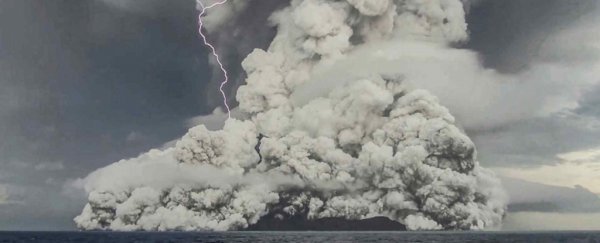By any measure you want to use, the Hunga Tonga-Hunga Ha'apai volcano eruption in January 2022 was a massive eruption.
It produced a swirling plume of gas, dust and ash that reached 58 kilometers (36 miles) into the sky, atmospheric waves that traveled around the globe several times, and tsunamis in the Caribbean on the other side of the world.
A newly published study now suggests why the scale of this volcanic blast was so huge: a smaller eruption the day before, priming the volcano for a bigger explosion by sinking its main vent under the surface of the ocean.
That meant molten rock was spewing out straight into seawater, vaporizing it along the way and intensifying the eruption. The vaporizing seawater caused the lava to fragment into tiny bits of ash, the researchers suggest.
Combined with ice crystals in the upper atmosphere, the roiling cloud of material built static charges that drove a dramatic period of lightning. The frenzy of electrical activity was so intense, in fact, it represented 80 percent of Earth's lightning strikes in its most active hour.
"We really just set out to try to understand what happened," says volcanologist Melissa Scruggs from the University of California, Santa Barbara. "So, we gathered all the information that we could, anything that was available within the first few weeks."
Scruggs and her colleagues think that almost 2 cubic kilometers (0.48 cubic miles) of material – weighing about 2,900 teragrams or 2.9 thousand million metric tons – was sent half way to space, causing violent ripple effects that were felt around the world.
The first two hours of the eruption were particularly violent, the researchers discovered, with the event starting at 5.02pm local time. After about 12 hours, activity at the site faded. It's the largest eruption we've seen since the 1991 blast from Mount Pinatubo in the Philippines, the researchers say.
Shockwaves traveling through the Pacific caused multiple tsunamis across the world, often arriving earlier than expected because the models used to chart them were based on earthquake activity rather than volcanic eruptions.
It's a warning about how dangerous submarine volcanoes can be, with the added ingredient of seawater. Many of these remain unmonitored – they're in remote locations, out of sight of satellite imagery – but the damage they can do can be cataclysmic, as the Hunga Tonga-Hunga Ha'apai eruption shows.
"The volume of the eruption was not the big deal," says geologist Frank Spera from the University of California, Santa Barbara. "What was special is how the energy of the eruption coupled to the atmosphere and oceans: a lot of the energy went into moving air and water on a global scale."
By the time the area had calmed down again, the islands of Hunga Tonga and Hunga Ha'apa had been all but obliterated. The islands were only created in 2015, after another large eruption from the same volcano made them the highest points on its crater.
Hunga Tonga-Hunga Ha'apai is what's known as a stratovolcano, a cone-shaped variety that usually gives rise to relatively mild volcanic activity. It's one of a line of volcanoes fed by magma from the tectonic activity: the Pacific Plate diving underneath the Indo-Australian Plate.
Plenty more data will be collected over time and you can expect plenty more studies looking at the cause and the effects of the 2022 Hunga Tonga-Hunga Ha'apai eruption – and making sure we're better prepared for the next one.
"Many aspects of this eruption await further investigation by multidisciplinary teams," write the researchers in their published paper.
"It represents a golden opportunity for fundamental research regarding the complex, non-linear behavior of high energetic volcanic eruptions and attendant phenomena, with critical implications for hazard mitigation, volcano forecasting, and first-response efforts in future disasters."
The research has been published in Earthquake Research Advances.
